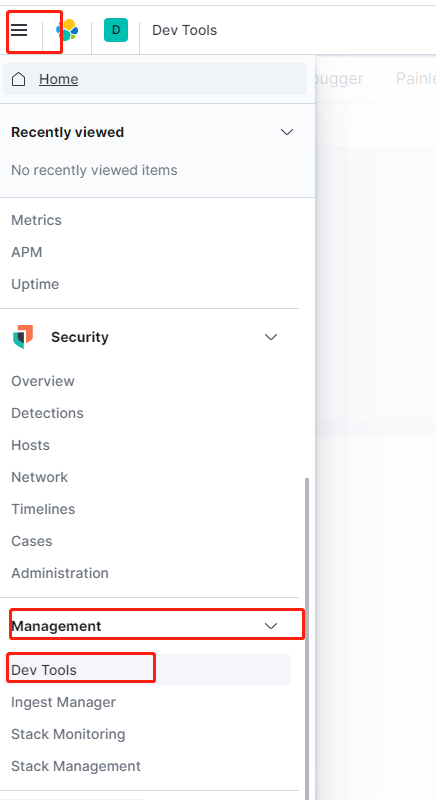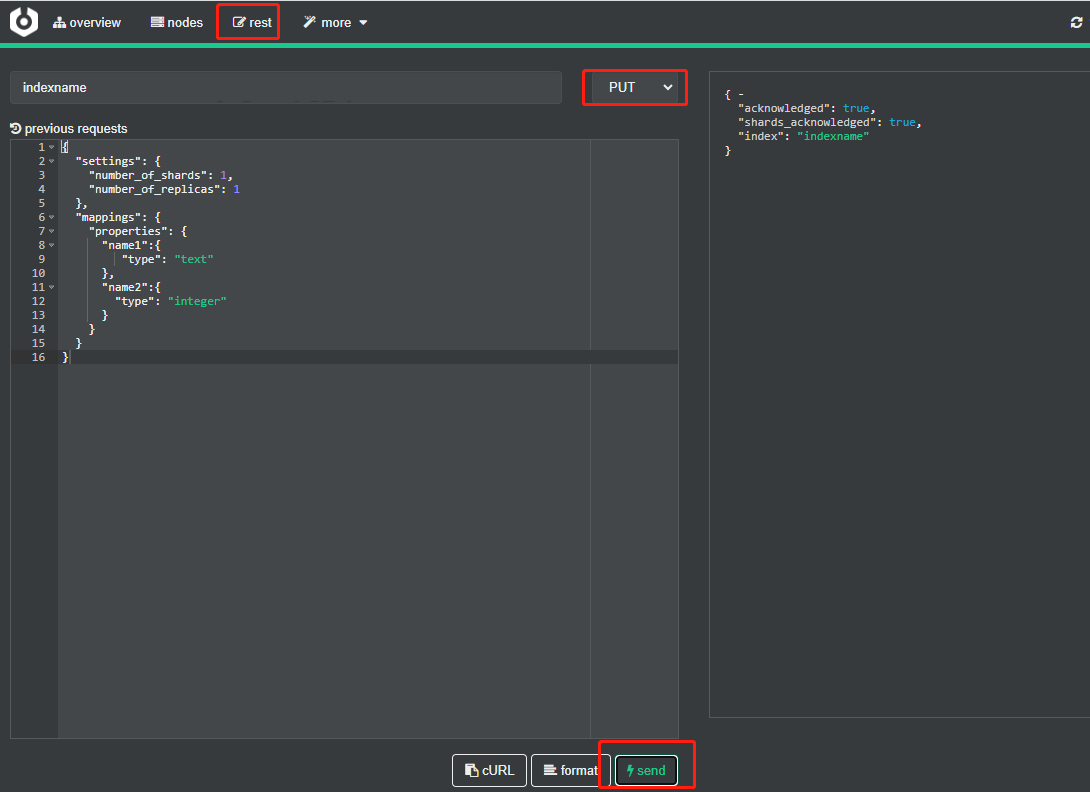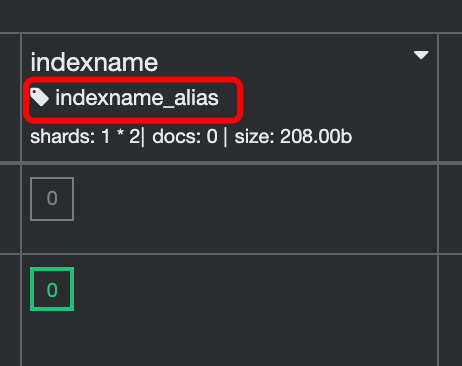# 2.1 索引操作
ES索引是存储数据的容器,类似于数据库。
# 2.1.1 创建索引
# 1. DSL语法
PUT indexname
{
"settings": {
"number_of_shards": 1,
"number_of_replicas": 1
},
"mappings": {
"properties": {
"name1":{
"type": "text"
},
"name2":{
"type": "integer"
}
}
}
}
# 1. 参数说明:
settings:索引信息设置
number_of_shards:每个索引的主分片数,这个配置在索引创建后不能修改
number_of_replicas:每个主分片的副本数,这个配置可以随时修改。
- 什么是分片?
Elasticsearch集群允许系统存储的数据量超过单机容量,这是通过shard实现的。在一个索引index中,数据(document)被分片处理(sharding)到多个分片上。也就是说:每个分片都保存了全部数据中的一部分。 一个分片是一个 Lucene 的实例,它本身就是一个完整的搜索引擎。文档被存储到分片内,但应用程序直接与索引而不是与分片进行交互。
- 什么是副本?
为了解决访问压力过大时单机无法处理所有请求的问题,Elasticsearch集群引入了副本策略replica。副本策略对index中的每个分片创建冗余的副本。
- 副本的作用如下:
提高系统容错性
当分片所在的机器宕机时,Elasticsearch可以使用其副本进行恢复,从而避免数据丢失。提高ES查询效率
处理查询时,ES会把副本分片和主分片公平对待,将查询请求负载均衡到副本分片和主分片。
mappings:索引映射定义
properties:字段定义 properties里是json配置,key为字段名称(自定义名称),value是个嵌套json,
type是指定字段的类型。
# 2. 语句运行:
- 语句可以直接复制在kibana中执行,选择
home下拉选择Management下的Dev Tools进行操作(Kibana只做简单介绍)

- 在cerebro中操作,选择
rest编辑DSL语句,点击send请求(要操作的地方已经标红)

右侧是创建成功结果
{ -
"acknowledged": true,
"shards_acknowledged": true,
"index": "indexname"
}
cerebro创建索引其他方式:选择 more 里面有很多配置, 点击 create index 也可以创建索引
# 2. Java API
在第一章已经介绍过一些创建索引的代码了
//从Spring容器获取client对象
@Autowired
private RestHighLevelClient client;
@RequestMapping("/createIndex")
public Boolean createIndex(String indexName) {
//创建索引请求类,构造函数参数为索引名称
CreateIndexRequest request = new CreateIndexRequest(indexName);
//设置source映射字符串,直接把语句复制里面
request.source(
"{\n" +
" \"settings\": {\n" +
" \"number_of_shards\": 1,\n" +
" \"number_of_replicas\": 1\n" +
" },\n" +
" \"mappings\": {\n" +
" \"properties\": {\n" +
" \"name1\":{\n" +
" \"type\": \"text\"\n" +
" },\n" +
" \"name2\":{\n" +
" \"type\": \"integer\"\n" +
" }\n" +
" }\n" +
" }\n" +
"}",
XContentType.JSON);
try {
//调用创建索引语法
client.indices().create(request, RequestOptions.DEFAULT);
return true;
} catch (IOException e) {
e.printStackTrace();
}
return false;
}
注意这里调用的方法是source,不是mapping
mapping方法是仅设置字段
source方法是带上settings内容一块调用的
# 2.1.2 删除索引
# 1. DSL语法
DELETE indexname
调用执行,以下返回结果为成功
{ -
"acknowledged": true
}
# 2. Java API
//从Spring容器获取client对象
@Autowired
private RestHighLevelClient client;
@RequestMapping("/deleteIndex")
public Boolean deleteIndex(String indexName) {
//删除索引请求类,构造函数参数为索引名称
DeleteIndexRequest deleteIndexRequest = new DeleteIndexRequest(indexName);
try {
//调用删除索引语法
client.indices().delete(deleteIndexRequest, RequestOptions.DEFAULT);
return true;
} catch (IOException e) {
e.printStackTrace();
}
return false;
}
# 2.1.3 判断索引存在
# 1. DSL语法
HEAD indexname
如果索引存在,服务器将返回200状态码;如果索引不存在,服务器将返回404状态码。
200 - OK
# 2. Java API
@Autowired
private RestHighLevelClient client;
@RequestMapping("/existsIndex")
public Boolean existsIndex(String indexName) {
GetIndexRequest request = new GetIndexRequest(indexName);
try {
return client.indices().exists(request, RequestOptions.DEFAULT);
} catch (IOException e) {
e.printStackTrace();
}
return false;
}
# 2.1.4 开启/关闭索引
什么是 Elasticsearch 打开/关闭索引?
一旦索引被关闭,那么这个索引只能显示元数据信息,不能够进行读写操作。 再说说打开索引就好理解了。就是打开被关闭的索引,允许进行读写操作。
# 1. 关闭索引
# 1. DSL语法
POST indexname/_close
调用执行,以下返回结果为成功
{ -
"acknowledged": true,
"shards_acknowledged": true,
"indices": { -
"indexname": { -
"closed": true
}
}
}
# 2. Java API
@RequestMapping("/closeIndex")
public Boolean closeIndex(String indexName) {
CloseIndexRequest closeIndexRequest = new CloseIndexRequest(indexName);
try {
client.indices().close(closeIndexRequest, RequestOptions.DEFAULT);
} catch (IOException e) {
e.printStackTrace();
}
return true;
}
# 2. 开启索引
# 1. DSL语法
POST indexname/_open
调用执行,以下返回结果为成功
{ -
"acknowledged": true,
"shards_acknowledged": true
}
# 2. Java API
@RequestMapping("/openIndex")
public Boolean openIndex(String indexName) {
OpenIndexRequest openIndexRequest = new OpenIndexRequest(indexName);
try {
client.indices().open(openIndexRequest, RequestOptions.DEFAULT);
} catch (IOException e) {
e.printStackTrace();
}
return true;
}
# 2.1.5 索引别名
索引别名概述:
在ES中,索引别名(index aliases)就像一个快捷方式或软连接,可以指向一个或多个索引。 别名有什么用?
给多个索引设置一个别名,可以使用这个别名同时查询多个索引的数据。
例如一个项目场景,每天要建立一个新的索引,程序要查询新的索引数据,程序必然要改变访问的索引名称,如果实现用户无感知切换,那么代码复杂度较高,很容易会对服务的使用者产生一定的影响,过程越复杂,BUG就越容易出现。
那么有了别名后,可以一开始就给索引加上这个别名,程序只关注访问这个别名,建立新索引后,把别名切换到新索引,程序不用变更,但是后续访问到了新的索引,并且无需停止应用的运行。当然这只是一个场景,在项目开发中,别名还有很多的用途,在后续项目讲解中我们会更多的介绍索引。
字段也有别名,使用率不太高,这里不过多讲解
# 1. 添加别名
创建索引别名,将别名indexname_alias与索引indexname关联
# 1. DSL语法
- 请求方式1
PUT indexname/_alias/indexname_alias
- 请求方式2
POST _aliases
{
"actions": [
{
"add": {
"index": "indexname",
"alias": "indexname_alias"
}
}
]
}
# 2. Java API语法
@Autowired
private RestHighLevelClient client;
@RequestMapping("/addAlias")
public Boolean addAlias(String indexName, String aliasName) {
IndicesAliasesRequest indicesAliasesRequest = new IndicesAliasesRequest();
IndicesAliasesRequest.AliasActions aliasActions = new IndicesAliasesRequest.AliasActions(IndicesAliasesRequest.AliasActions.Type.ADD);
aliasActions.index(indexName).alias(aliasName);
indicesAliasesRequest.addAliasAction(aliasActions);
try {
client.indices().updateAliases(indicesAliasesRequest, RequestOptions.DEFAULT);
} catch (IOException e) {
e.printStackTrace();
}
return true;
}
接口接收两个参数,indexName:索引名,aliasName:要增加的别名
打开地址调用接口
http://localhost:8080/addAlias?indexName=indexname&aliasName=indexname_alias (opens new window)
# 2. 删除别名
删除索引别名:解除别名indexname_alias与索引indexname的关联
# 1. DSL语法
- 请求方式1
DELETE indexname/_alias/indexname_alias
- 请求方式2
POST _aliases
{
"actions": [
{
"remove": {
"index": "indexname",
"alias": "indexname_alias"
}
}
]
}
# 2. Java API语法
@Autowired
private RestHighLevelClient client;
@RequestMapping("/removeAlias")
public Boolean removeAlias(String indexName, String aliasName) {
IndicesAliasesRequest indicesAliasesRequest = new IndicesAliasesRequest();
IndicesAliasesRequest.AliasActions aliasActions = new IndicesAliasesRequest.AliasActions(IndicesAliasesRequest.AliasActions.Type.REMOVE);
aliasActions.index(indexName).alias(aliasName);
indicesAliasesRequest.addAliasAction(aliasActions);
try {
client.indices().updateAliases(indicesAliasesRequest, RequestOptions.DEFAULT);
} catch (IOException e) {
e.printStackTrace();
}
return true;
}
和增加一样,接口接收两个参数,indexName:索引名,aliasName:要增加的别名
打开地址调用接口
http://localhost:8080/removeAlias?indexName=indexname&aliasName=indexname_alias (opens new window)
# 3. 切换别名
切换一个别名是在同一个API中执行添加、删除操作。这个操作是原子的,不用担心别名不指向索引的短时间。
请读者自行创建两个索引 indexname1 和 indexname2,为了防止没必要的出错,请先给indexname2加上别名。
# 1. DSL语法
POST _aliases
{
"actions": [
{
"add": {
"index": "indexname1",
"alias": "indexname_alias"
}
},
{
"remove": {
"index": "indexname2",
"alias": "indexname_alias"
}
}
]
}
# 2. Java API语法
@Autowired
private RestHighLevelClient client;
@RequestMapping("/changeAlias")
public Boolean changeAlias() {
String aliasName = "indexname_alias";
IndicesAliasesRequest indicesAliasesRequest = new IndicesAliasesRequest();
IndicesAliasesRequest.AliasActions addAliasActions = new IndicesAliasesRequest.AliasActions(IndicesAliasesRequest.AliasActions.Type.ADD);
addAliasActions.index("indexname1").alias(aliasName);
IndicesAliasesRequest.AliasActions removeAliasActions = new IndicesAliasesRequest.AliasActions(IndicesAliasesRequest.AliasActions.Type.REMOVE);
removeAliasActions.index("indexname2").alias(aliasName);
indicesAliasesRequest.addAliasAction(addAliasActions);
indicesAliasesRequest.addAliasAction(removeAliasActions);
try {
client.indices().updateAliases(indicesAliasesRequest, RequestOptions.DEFAULT);
} catch (IOException e) {
e.printStackTrace();
}
return true;
}
打开地址调用接口
http://localhost:8080/changeAlias (opens new window)
# 4. 查看别名
确认别名是否存在的话,可以在cerebro平台直接查看

也可以在 more 里选择 aliases 看所有索引的别名情况,这里也可以修改,功能非常的全面

# 1. DSL语法
- 通过别名查询索引
GET _alias/indexname_alias
根据返回结果所示,indexname 索引下有这个别名
{ -
"indexname": { -
"aliases": { -
"indexname_alias": { -
}
}
}
}
- 通过索引查询别名
GET indexname/_alias
- 查看别名是否存在索引中
GET indexname/_alias/indexname_alias
# 2. Java API语法
- 通过别名查询索引
@Autowired
private RestHighLevelClient client;
@RequestMapping("/selectIndexByAlias")
public Map selectIndexByAlias(String aliasName) {
GetAliasesRequest getAliasesRequest = new GetAliasesRequest(aliasName);
try {
GetAliasesResponse response = client.indices().getAlias(getAliasesRequest,RequestOptions.DEFAULT);
Map<String, Set<AliasMetadata>> aliases;
aliases = response.getAliases();
return aliases;
} catch (IOException e) {
e.printStackTrace();
}
return null;
}
打开地址调用接口,页面出现返回结果
http://localhost:8080/selectIndexByAlias?aliasName=indexname_alias (opens new window)
- 通过索引查询别名
@Autowired
private RestHighLevelClient client;
@RequestMapping("/selectAliasByIndex")
public Map selectAliasByIndex(String indexName) {
GetAliasesRequest getAliasesRequest = new GetAliasesRequest();
// 指定查看某一个索引的别名 不指定,则会搜索所有的别名
getAliasesRequest.indices(indexName);
try {
GetAliasesResponse response = client.indices().getAlias(getAliasesRequest,RequestOptions.DEFAULT);
Map<String, Set<AliasMetadata>> aliases;
aliases = response.getAliases();
return aliases;
} catch (IOException e) {
e.printStackTrace();
}
return null;
}
打开地址调用接口,页面出现返回结果
http://localhost:8080/selectAliasByIndex?indexName=indexname1 (opens new window)
- 查看别名是否存在索引中
@Autowired
private RestHighLevelClient client;
@RequestMapping("/getAliasExist")
public Boolean getAliasExist(String indexName, String aliasName) {
GetAliasesRequest getAliasesRequest = new GetAliasesRequest(aliasName);
getAliasesRequest.indices(indexName);
try {
return client.indices().existsAlias(getAliasesRequest, RequestOptions.DEFAULT);
} catch (IOException e) {
e.printStackTrace();
}
return false;
}
打开地址调用接口,页面出现返回结果
http://localhost:8080/getAliasExist?indexName=indexname&aliasName=indexname_alias (opens new window)